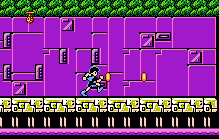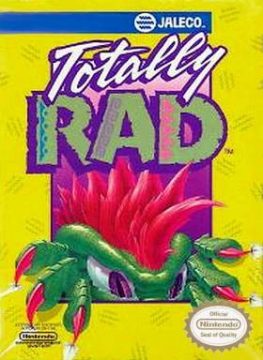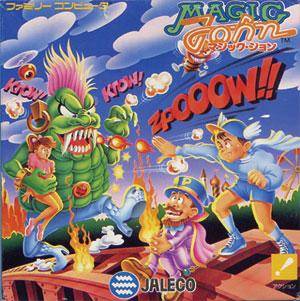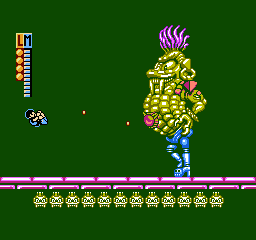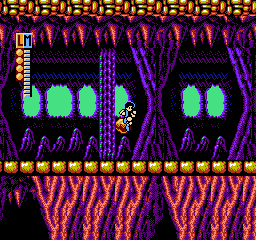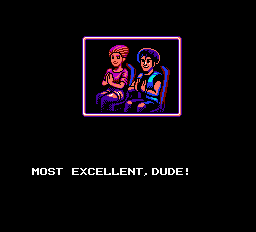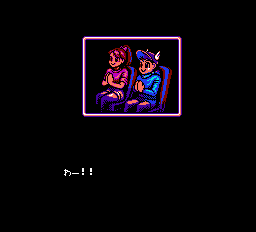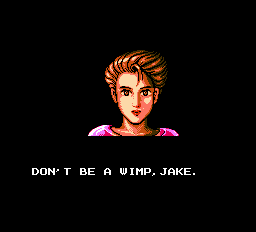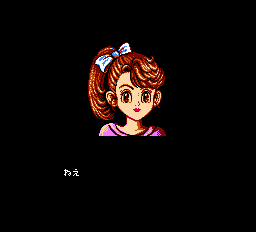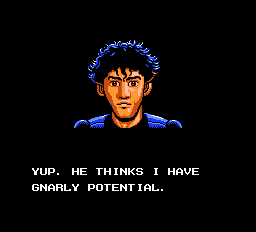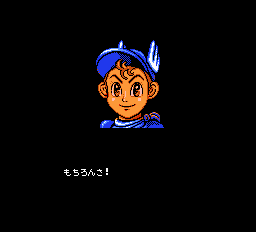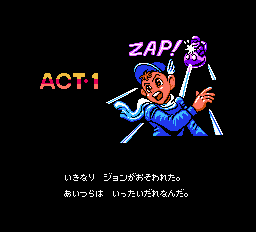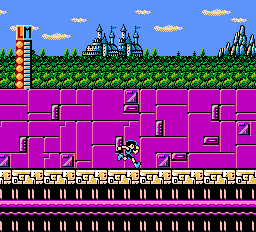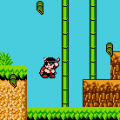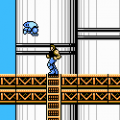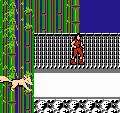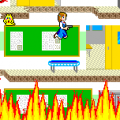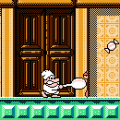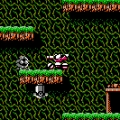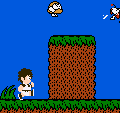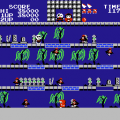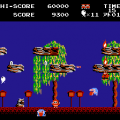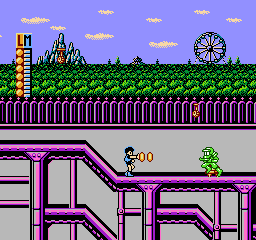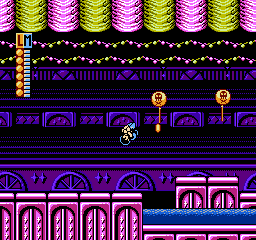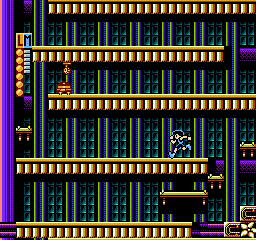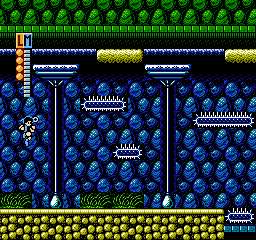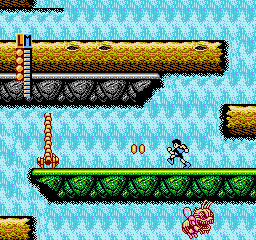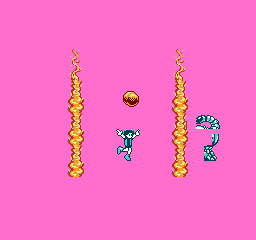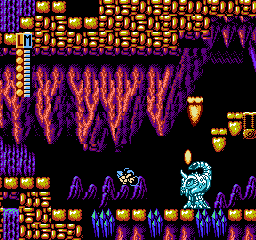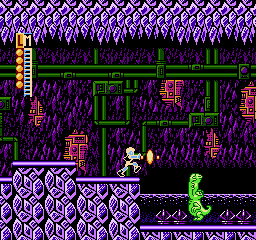While Jaleco was never the most impactful company on the NES, they at least held a decent degree of success with their Bases Loaded sports series and their license on the NES version of Maniac Mansion among other things. Somewhere along their release catalog was an obscure little action platformer that, while not incredibly original, proved to be a decent game. Then again, considering this game was given the embarrassing title “Totally Rad“, it likely remained obscure and unbought by lots of people. That name alone smacks of the early nineties dark trend in which all sorts of “cool” lingo and buzzwords peppered every form of media in an attempt to grab Generation X. To be sure, the game’s manual and even the game’s English localization further capitalizes on this premise. Shedding away that blush-worthy aspect gives us a fine game that is yet another one of those unknown NES titles from the system’s latter years, overshadowed by the advent of the Super Nintendo.
Totally Rad is about a dude, a babe, and a super-groovy magician, or at least that’s more or less the “cool” way to tell the tale. The story is patently ridiculous, further complimented by cutscenes at the beginning and in between each stage, wherein the trials of the protagonist Jake are detailed. Jake and his girlfriend Allison are enthralled by the great magician Zebediah Pong, who may be an ostensible stage magician but has legitimate magical power. For no apparent reason, Zebediah imparts everything he knows to Jake and trusts that he’ll become a magical wunderkind with his newfound knowledge. Unfortunately, a bunch of weird-looking creeps nab Allison and Jake must now put his magic to the ultimate test in order to save his beloved. Jake and Allison themselves use the hell out of the nineties surfer vernacular that it’s simultaneously obnoxious and amusing for how ridiculous it all is. If you prefer to focus more on the “obnoxious” caveat, then avoid the game’s manual, whose attempts at humor are one of the few things in video game booklet history to rival the infamous manuals of American Konami games.
Putting all of the text aside, Totally Rad‘s release in the latter days of the NES compliments its visual appeal. The graphics are incredibly colorful, perhaps even a bit egregiously so. If you wanted a virtual rainbow simulator, Totally Rad comes pretty danged close to such an experience. The backgrounds use every possible color that the NES can generate, ranging from the large purple wall in front of the forest of the first level, the big city lights of the second stage, to the glowing crystals and machines of the underground in the later levels.
Enemies are often toned in a singular color setting, like the yellow helicopter eyes or the green armored soldiers, and there are quite a few bizarre designs among the monsters. One mutant can only be described as a purple combination of Wolverine and Mike Haggar. While not the most technically advanced title on the system, it at least looks decent and creates a world that doesn’t tilt too far out into the spectrums of whimsy or realism. On the flipside of technology, the sound quality is fairly good on the whole, except for the weak percussion that sounds more like a low-tech laser gun firing out farts to the beat. Aside from that somewhat annoying sound, the music is otherwise catchy and often fitting to the current stage; one of the standout tracks provides an even screwier version of the classic circus theme, Entrance of the Gladiators, and appropriately enough, it takes place in a circus big top. The boss theme is especially fast-paced and gets you pumped up to attack the gigantic monstrosity advancing on you.
The game itself plays like most other platformers that involve a good deal of shooting, somewhat akin to a slightly slower version of Mega Man. Jake’s default attack is that of a psychic blast which he can shoot quickly for a single shot, charge a bit for a double shot, or charge until glowing for a penetrating triple shot. This attack uncannily resembles Mega Man’s mega buster, except this game was released a bit before the Blue Bomber received the ability to charge his shots in Mega Man 4. You can only fire charged shots from the ground, and you automatically release any shots the instant you jump, which can get annoying at times. There are some boss fights where the ability to fire a charged jump shot would be useful, as your regular shot is rather weak for damage. Even if charged blasts don’t work in the air, there’s still a helpful power working in your favor in the form of special magic. These twelve spells can be selected while you have the game paused and are used by pressing B while holding up, just like using subweapons in Castlevania. Every spell you use uses up either two or four notches of your magic meter, and it does not refill until the stage midpoint or end, so you must be judicious in your magic use.
The magic you’re most likely to use at any given time is the half heart, which takes two bars to restore three points of life. The full heart restores your entire life but at a larger cost of four magic bars, and it is usually more efficient to cast the half heart spell at any given time. There’s also magic that can freeze time (a la the stopwatch from Castlevania) and make you invincible, both of which can be useful in certain situations but not to the general level of the life-ups. There are also four different elemental attack magics which rend the battlefield asunder with either fire, water, wind, or earth attacks which actually become more powerful at the start of stages 2 and 4. There doesn’t really seem to be any difference between the strengths of these screen-clearers, and so far as can be told, the differences are cosmetic and come down to personal choice. It’s also not recommended you use these mega-attacks too much unless you really need to wipe out several enemies at once.
The most interesting magic spells are those which allows Jake to transform into another physical form: The aerodynamic eagleman, the strong lionman, and the elusive fishman. As the eagleman, you can stay in the air indefinitely by continuing to jump and fly about with your wings. As the lionman, you are invincible while jumping and your attack is powerful, even though your attack is short-ranged and you cannot do it in a jump. As the fishman, you can swim very well through water, a skill which is only useful in level 3; however, you can somehow shoot faster, so this form is not entirely worthless on land. You’ll need to transform back into Jake in order to use any other magic, and to do so, you pick the sneaker icon in the magic menu and change back with no meter penalty.
Careful use of magic and taking advantage of having no time limit are the best ways to make progress, as the enemies can be pretty vicious. Things get tough when you’re trying to dismantle missile-firing manholes that can only be hit while open, and buzzing around you is a large aggressive mutant fly which explodes into a stray bullet on death. The expected environmental traps like fire and spikes warrant the utmost of caution, and even if they do not instantly kill you, Jake only has six life points with several attacks likely to take away two pips instead of just one. Totally Rad can get somewhat bogus with its difficulty at points, even if it runs on a decent curve that starts out manageable and gradually becomes more outrageous with each new scenario.
Further pressing on the difficulty scale is a limit of three continues and three chances with each, giving you a sparse total of twelve overall tries with no way to restore them. Totally Rad is indeed a tough game that can be whipped with enough practice and learning what to expect, and its curve is also rounded by a decidedly short length. There are five stages in the game, each consisting of two parts and often not taking much longer than five to eight minutes on average. If the game was too much longer, the slim margin of error may have felt more punishing, but for the high challenge Totally Rad offers, the duration is just right. That being said, it will still take a good chunk of work to get through each level and the big bad boss you battle at their ends.
The most impressive spectacles of Totally Rad are the bosses, absolutely bar none. The game itself seems to be aware of this fact and often sets boss fights in a giant empty room, sometimes with a background color that can potentially be harsh on the eyes. Towering about ten sizes above poor Jake, these mondo monstrosities provide some rough challenges but can be beaten once you figure out their weak spots. Take the first boss, Rubyllia, a vaguely crocodilian beast whose body is apparently a giant corn cob, with shocking pink punk hair, giant earrings, strong arms, and platform shoes with a large gem in its navel. And he appears to attack by popping his kernels to hit you with large deadly popcorn.
Somewhat unfortunately, the rest of the bosses aren’t as crazily designed as this joker, but they’re no less impressive, what with Biclopter, the one-eyed one-legged hopping purple people eater (with a spare eye on its butt), Nautikill, the rainbow colored killer fish that spits more small fish at you, Fang, the massive cyber-skeleton thing that… actually, the bosses are all reasonably insane. Whatever the case, Rubyllia needs to be shot in its gutgem, Biclopter gets hit on either of its two eyes, and so on. However, these guys actually move pretty fast around the screen despite their hulking size, and they become increasingly difficult to deal with, forcing the harsh penalty of restarting from the midpoint of the stage if you die on them (or from the very beginning if you’re out of lives).
There are many games like Totally Rad that were released around the same time as it, and some of those are decidedly better, but it has a definite charm about it. Most probably won’t say that said charm is based on the dumb English localization, though a few may say it lends a distinct air to the game’s atmosphere. Setting that riff-raff aside, what’s left is an above-average 2D action game that, if not very innovative, at least provides a well-rounded example of the sort of game that made the NES what it was. While the title alone and gauche yellow cover is an understandable deterrent, judge not this game by its cover and give it a tubular tryout.
The game is known in Japan as Magic John, which plays the same as the American release but whose protagonists look ever so slightly different. Here, Jake and Allison are instead known as John and Yuu; their appearances are distinctly younger, and they’re simply friends instead of being mates. Their appearance here is distinctly more anime-esque, with John wearing a goofy winged cap and Yuu with her hair in a gravity-defying ponytail, and both naturally having unnaturally large eyes. John’s sprite is also different than Jake’s during gameplay, and the magic hat icon on the menu has been replaced with a magic shoe (since the hero no longer wears a hat), but the game is otherwise the same aside from the assumption that all the Japanese text is bereft of daft slang words. Oddly enough, Zebediah (only ever called Pong-sensei in Magic John) looks exactly the same over both versions, and why he was kept the same in Totally Rad is anyone’s guess.
Links:
The Rad Project – A look at the cutscene differences between Totally Rad and Magic John.
